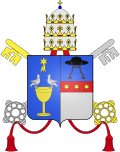Pope Gregory XVI
Pope Gregory XVI (Latin: [Gregorius PP. XVI] Error: {{Lang}}: text has italic markup (help), Italian: [Gregorio XVI] Error: {{Lang}}: text has italic markup (help); 18 September 1765 – 1 June 1846), born Bartolomeo Alberto Cappellari, was an Italian cleric of the Roman Catholic Church and the 255th Pope from 1831 to 1846.[1]
| Pope Gregory XVI | |
|---|---|
| Bishop of Rome | |
 | |
| Papacy began | 2 February 1831 |
| Papacy ended | 1 June 1846 |
| Predecessor | Pope Pius VIII |
| Successor | Pope Pius IX |
| Personal details | |
| Birth name | Bartolomeo Cappellari |
| Born | 8 September 1765 Belluno, Republic of Venice |
| Died | 1 June 1846 Rome, Italy |
| Other Popes named Gregory | |
Early life
Bartolomeo Alberto Cappellari was born in 1765 in Belluno, which was part of then in the Republic of Venice.[2]
Priest
He became a monk in 1783; and he took the name Mauro. Dom Mauro became a priest in 1787.[2]
Abbot
Pope Pius VII confirmed his election as Abbot Vicar of the San Gregorio Monastery in 1805.[2]
Cardinal
Pope
In 1831, Cardinal Capillaria was elected Pope; and he chose to be called Gregory Gregory.[2]
He use Austrian troops to stop a revolution in the Papal States.[3]
Pope Gregory XVI Media
"The Grand Gala Berlin" is a luxury carriage constructed in Rome during the first half of the nineteenth century. It is the work of two pontiffs: Leo XII, who called for it to be produced in 1824–1826, and Gregory XVI, who requested some important modifications.
Pope Gregory XVI leading a Eucharistic procession. Painting by Ferdinando Cavalleri (1840)
Pope Gregory XVI visiting the Church of San Benedetto at Subiaco, Lazio. Painting by Jean-François Montessuy (1843)
Related pages
References
- ↑ "List of Popes," Catholic Encyclopedia (2009); retrieved 2012-6-29.
- ↑ 2.0 2.1 2.2 2.3 2.4 "Pope Gregory XVI," Catholic Encyclopedia; retrieved 2012-6-29.
- ↑ "Gregory XVI (1765-1846)," Who's Who in Christianity; retrieved 2012-7-18.
Other websites
![]() Media related to Gregorius XVI at Wikimedia Commons
Media related to Gregorius XVI at Wikimedia Commons
 "Pope Gregory XVI". Catholic Encyclopedia. New York: Robert Appleton Company. 1913.
"Pope Gregory XVI". Catholic Encyclopedia. New York: Robert Appleton Company. 1913.- "Gregory XVI", Encyclopædia Britannica, 1911
- Catholic Hierarchy, Pope Gregory XVI
- Cardinals of the Holy Roman Church Archived 2011-10-30 at the Wayback Machine, Cardinal Capillaria Archived 2012-08-06 at the Wayback Machine
| Preceded by Pius VIII |
Pope 1831–1846 |
Succeeded by Pius IX |





